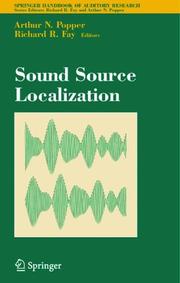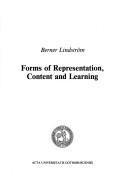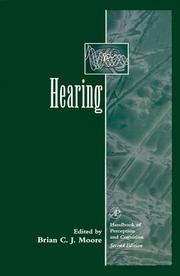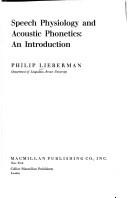Book
ISBN: 1527531244 9781527531246 1527523888 9781527523883 Year: 2019 Publisher: Newcastle upon Tyne
Abstract | Keywords | Export | Availability | Bookmark
 Loading...
Loading...Choose an application
- Reference Manager
- EndNote
- RefWorks (Direct export to RefWorks)
Auditory perception. --- Space perception. --- Spatial perception --- Perception --- Spatial behavior --- Figure-ground perception --- Geographical perception --- Sound perception --- Hearing --- Word deafness --- Klankobservatie --- Analyses --- Sociologie

ISBN: 128060817X 9786610608171 0387288635 038724185X 1441920226 Year: 2005 Publisher: New York : Springer,
Abstract | Keywords | Export | Availability | Bookmark
 Loading...
Loading...Choose an application
- Reference Manager
- EndNote
- RefWorks (Direct export to RefWorks)
The localization of sound is a fundamental requirement for all auditory systems and has motivated much research. This comprehensive volume brings together topics from many specialties that have been touched upon in other volumes of the Springer Handbook of Auditory Research. Reviewing sound source localization capacities and mechanisms in a variety of organisms, this volume provides a synthesis and update on the topic that is both original and timely. The authors treat sound source localization in a comparative context with an emphasis on modeling and computational mechanisms. About the Editors: Arthur N. Popper is Professor in the Department of Biology and Co-Director of the Center for Comparative and Evolutionary Biology of Hearing at the University of Maryland, College Park. Richard R. Fay is Director of the Parmly Hearing Institute and Professor of Psychology at Loyola University of Chicago. .
Directional hearing. --- Auditory perception. --- Sound perception --- Hearing --- Perception --- Word deafness --- Auditory localization --- Localization, Auditory --- Sound, Localization of --- Sound localization (Physiology) --- Auditory scene analysis --- Neurobiology. --- Neurosciences. --- Zoology. --- Biology --- Natural history --- Animals --- Neural sciences --- Neurological sciences --- Neuroscience --- Medical sciences --- Nervous system --- Neurosciences
Book
ISBN: 0805800204 080580384X Year: 1989 Publisher: Hillsdale, NJ ; Hove : Lawrence Erlbaum Associates [LEA],
Abstract | Keywords | Export | Availability | Bookmark
 Loading...
Loading...Choose an application
- Reference Manager
- EndNote
- RefWorks (Direct export to RefWorks)
Auditory perception --- Psychology, Comparative --- Behavior, Comparative --- Comparative behavior --- Comparative psychology --- Ethology, Comparative --- Intelligence of animals --- Zoology --- Animal behavior --- Animal intelligence --- Animal psychology --- Human behavior --- Instinct --- Sound perception --- Hearing --- Perception --- Word deafness
Book
ISBN: 0898599814 Year: 1987 Publisher: Hillsdale Erlbaum
Abstract | Keywords | Export | Availability | Bookmark
 Loading...
Loading...Choose an application
- Reference Manager
- EndNote
- RefWorks (Direct export to RefWorks)
Auditory Perception. --- Hearing. --- Auditory perception --- -Psychoacoustics --- -Psychophysics --- Sound --- Sound perception --- Hearing --- Perception --- Word deafness --- Audition --- Auditory Perceptions --- Perception, Auditory --- Perceptions, Auditory --- Auditory Perceptual Disorders --- Congresses --- Psychoacoustics --- Congresses. --- -Congresses --- Auditory Perception --- Psychophysics --- Auditory Processing --- Processing, Auditory

ISBN: 9173460818 Year: 1980 Publisher: Göteborg Acta universitatis Gothoburgensis
Abstract | Keywords | Export | Availability | Bookmark
 Loading...
Loading...Choose an application
- Reference Manager
- EndNote
- RefWorks (Direct export to RefWorks)
Learning, Psychology of --- Visual perception --- Auditory perception --- Sound perception --- Hearing --- Perception --- Word deafness --- Optics, Psychological --- Vision --- Visual discrimination --- Learning --- Psychology of learning --- Educational psychology --- Comprehension --- Learning ability --- Psychological aspects --- Learning, Psychology of. --- Visual perception. --- Auditory perception.
Book
ISBN: 0262518023 026211318X 026228975X 9786613020109 1283020106 0262296810 9780262289757 9780262518024 9780262113182 9781283020107 6613020109 9780262296816 Year: 2011 Publisher: Cambridge, Mass. MIT Press
Abstract | Keywords | Export | Availability | Bookmark
 Loading...
Loading...Choose an application
- Reference Manager
- EndNote
- RefWorks (Direct export to RefWorks)
An integrated overview of hearing and the interplay of physical, biological, and psychological processes underlying it.Every time we listen--to speech, to music, to footsteps approaching or retreating--our auditory perception is the result of a long chain of diverse and intricate processes that unfold within the source of the sound itself, in the air, in our ears, and, most of all, in our brains. Hearing is an "everyday miracle" that, despite its staggering complexity, seems effortless. This book offers an integrated account of hearing in terms of the neural processes that take place in different parts of the auditory system.Because hearing results from the interplay of so many physical, biological, and psychological processes, the book pulls together the different aspects of hearing--including acoustics, the mathematics of signal processing, the physiology of the ear and central auditory pathways, psychoacoustics, speech, and music--into a coherent whole.
Auditory perception. --- Auditory pathways. --- Hearing. --- Acoustics --- Audition (Physiology) --- Physiological acoustics --- Auditory system --- Sound perception --- Bioacoustics --- Senses and sensation --- Audiology --- Auditory pathways --- Deafness --- Ear --- Listening --- Afferent pathways --- Hearing --- Perception --- Word deafness --- NEUROSCIENCE/General

ISBN: 0125056265 9786611186630 1281186635 0080533868 9780080533865 9780125056267 9781281186638 Year: 1995 Publisher: San Diego Academic Press
Abstract | Keywords | Export | Availability | Bookmark
 Loading...
Loading...Choose an application
- Reference Manager
- EndNote
- RefWorks (Direct export to RefWorks)
Hearing is a comprehensive, authoritative reference work covering both the physiological and perceptual aspects of hearing. Intended for researchers and advanced students in the field of hearing, it reviews major areas of research in addition to new discoveries, including active mechanisms in the cochlea, across-channel processes in auditory masking, and perceptual grouping processes.Key Features* Covers both physiological and perceptual aspects of hearing* Authoritative reviews by experts in the field* Comprehensive up-to-date coverage* An integrated work with e
Auditory perception --- Hearing --- Psychoacoustics --- Psychophysics --- Sound --- Acoustics --- Audition (Physiology) --- Physiological acoustics --- Bioacoustics --- Senses and sensation --- Audiology --- Auditory pathways --- Deafness --- Ear --- Listening --- Sound perception --- Perception --- Word deafness --- Auditory perception. --- Hearing. --- Psychoacoustics.
Book
ISBN: 1283039761 9786613039767 2759803465 9782759803460 9782759800988 9781283039765 6613039764 Year: 2009 Publisher: Les Ulis : EDP Sciences,
Abstract | Keywords | Export | Availability | Bookmark
 Loading...
Loading...Choose an application
- Reference Manager
- EndNote
- RefWorks (Direct export to RefWorks)
Les mystères de l'ouïe sont ici disséqués et analysés et devraient intéresser tous les spécialistes de notre appareil auditif. Comment entendons-nous ? La cochlée (ou limaçon) n'est-elle qu'un banal microphone ou s'agit-il d'un analyseur des sons qui nous agressent ? ou procède-t-elle différemment ? Par exemple sous la forme d'un convertisseur du signal acoustique en impulsions nerveuses sans décomposition préalable des sons ? Comment le message sonore est-il capté et codé avant d'être transmis au cerveau ? En quoi le numérique peut-il interférer dans ce mystérieux processus ? Jusqu'à ce jour a prévalué l'idée que l'oreille effectuait une analyse des sons complexes, comme sur un piano, mais ce postulat rencontre tellement d'objections qu'il est indispensable de concevoir un autre modèle. Les structures de l'oreille et la physiologie des fibres nerveuses sont pourtant particulièrement bien adaptées à l'analyse et à la transmission des informations sonores par l'intervention d'un échantillonnage des formes imprimées par les sons Les théories modernes de l'information et de la communication viennent fort heureusement à notre secours et éclairent d'un jour nouveau les multiples énigmes relevées dans les domaines de la psycho-acoustique, de la physiologie de l'audition et évidemment des troubles auditifs. Comment, par exemple, interpréter les dégâts provoqués par un traumatisme sonore, la survenue obsédante d'acouphènes, ou les difficultés rencontrées par la prothèse auditive ? Cet ouvrage, par son originalité, ne manquera certainement pas d'intéresser les professionnels de l'audition : acousticiens, O.R.L., audioprothésistes, orthophonistes, etc. et de près ou de loin, tous ceux qui se sentent concernés par la perception du monde sonore.
Auditory perception. --- Hearing disorders. --- Hearing aids. --- Hearing aids, Mechanical --- Auditory disorders --- Defective hearing --- Disorders of hearing --- Hearing defects --- Hearing impairments --- Sound perception --- Audiology --- Prosthesis --- Communicative disorders --- Disabilities --- Ear --- Sensory disorders --- Hearing --- Perception --- Word deafness --- Instruments --- Diseases
Book
ISBN: 9782889196678 Year: 2015 Publisher: Frontiers Media SA
Abstract | Keywords | Export | Availability | Bookmark
 Loading...
Loading...Choose an application
- Reference Manager
- EndNote
- RefWorks (Direct export to RefWorks)
Compared to other sensory systems, the auditory system has evolved a large number of subthalamic nuclei each devoted to processing distinct features of sound stimuli. This information once extracted is then re-assembled to form the percept the acoustic world around us. The well-understood function of many of these auditory nuclei has enhanced our understanding of inhibition's role in shaping their responses from easily distinguished inhibitory inputs. In particular, neurons devoted to processing the location of sound sources receive a complement of discrete inputs for which in vivo activity and function are well understood. Investigation of these areas has led to significant advances in understanding the development, physiology, and mechanistic underpinnings of inhibition that apply broadly to neuroscience.
Auditory perception --- Neurons --- Neurology. --- Cytology. --- Nerve cells --- Neurocytes --- Cells --- Nervous system --- Sound perception --- Hearing --- Perception --- Word deafness --- Medicine --- Neuropsychiatry --- Diseases --- Gap Junctions --- Sound Localization --- GABA --- inhibition --- plasticity --- Nitric Oxide --- MNTB --- Glycine --- co-release

ISBN: 0023706201 Year: 1977 Publisher: New York Macmillan
Abstract | Keywords | Export | Availability | Bookmark
 Loading...
Loading...Choose an application
- Reference Manager
- EndNote
- RefWorks (Direct export to RefWorks)
Auditory perception --- Phonetics --- Speech --- KVH-BOM --- #KVHB:Anatomie en fysiologie --- #KVHB:Fonetiek --- #KVHB:Spraak --- #KVHB:Spraakorganen --- Articulatory phonetics --- Orthoepy --- Phonology --- Linguistics --- Sound perception --- Hearing --- Perception --- Word deafness --- Physiological aspects --- Physiology of the respiratory system

 Search
Search Feedback
Feedback About UniCat
About UniCat  Help
Help News
News